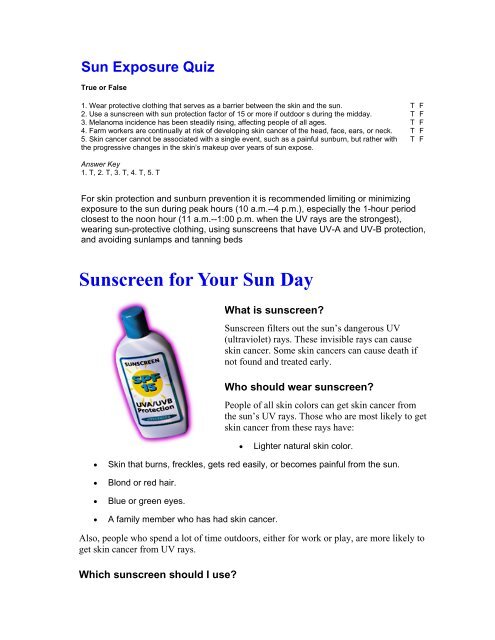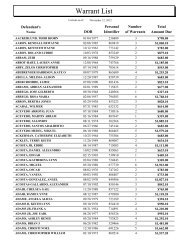Sunscreen for Your Sun Day
Sunscreen for Your Sun Day
Sunscreen for Your Sun Day
You also want an ePaper? Increase the reach of your titles
YUMPU automatically turns print PDFs into web optimized ePapers that Google loves.
<strong>Sun</strong> Exposure Quiz<br />
True or False<br />
1. Wear protective clothing that serves as a barrier between the skin and the sun. T F<br />
2. Use a sunscreen with sun protection factor of 15 or more if outdoor s during the midday. T F<br />
3. Melanoma incidence has been steadily rising, affecting people of all ages. T F<br />
4. Farm workers are continually at risk of developing skin cancer of the head, face, ears, or neck. T F<br />
5. Skin cancer cannot be associated with a single event, such as a painful sunburn, but rather with<br />
the progressive changes in the skin’s makeup over years of sun expose.<br />
T F<br />
Answer Key<br />
1. T, 2. T, 3. T, 4. T, 5. T<br />
For skin protection and sunburn prevention it is recommended limiting or minimizing<br />
exposure to the sun during peak hours (10 a.m.--4 p.m.), especially the 1-hour period<br />
closest to the noon hour (11 a.m.--1:00 p.m. when the UV rays are the strongest),<br />
wearing sun-protective clothing, using sunscreens that have UV-A and UV-B protection,<br />
and avoiding sunlamps and tanning beds<br />
<strong><strong>Sun</strong>screen</strong> <strong>for</strong> <strong>Your</strong> <strong>Sun</strong> <strong>Day</strong><br />
What is sunscreen?<br />
<strong><strong>Sun</strong>screen</strong> filters out the sun’s dangerous UV<br />
(ultraviolet) rays. These invisible rays can cause<br />
skin cancer. Some skin cancers can cause death if<br />
not found and treated early.<br />
Who should wear sunscreen?<br />
People of all skin colors can get skin cancer from<br />
the sun’s UV rays. Those who are most likely to get<br />
skin cancer from these rays have:<br />
• Lighter natural skin color.<br />
• Skin that burns, freckles, gets red easily, or becomes painful from the sun.<br />
• Blond or red hair.<br />
• Blue or green eyes.<br />
• A family member who has had skin cancer.<br />
Also, people who spend a lot of time outdoors, either <strong>for</strong> work or play, are more likely to<br />
get skin cancer from UV rays.<br />
Which sunscreen should I use?
Use a sunscreen with a <strong>Sun</strong> Protection Factor (SPF) of 15 or higher. <strong><strong>Sun</strong>screen</strong>s come in<br />
many <strong>for</strong>ms, including ointments, creams, gels, lotions, wax sticks, and sprays.<br />
Follow the directions on the package <strong>for</strong> using a sunscreen product on babies less than 6<br />
months old. All products do not have the same ingredients; if your or your child’s skin<br />
reacts badly to one product, try another one or call a doctor.<br />
When do I need to apply sunscreen?<br />
The sun’s UV rays can damage your skin in as little as 15 minutes. Put sunscreen on<br />
be<strong>for</strong>e you go outside, even on slightly cloudy or cool days. Don’t <strong>for</strong>get to put a thick<br />
layer on all parts of exposed skin. Get help <strong>for</strong> hard-to-reach places like your back.<br />
<strong><strong>Sun</strong>screen</strong> wears off. Put it on again if you stay out in the sun <strong>for</strong> more than 2 hours, and<br />
after you swim or do things that make you sweat.<br />
<strong><strong>Sun</strong>screen</strong>: How To Select, Apply, and Use It Correctly<br />
When To Apply <strong><strong>Sun</strong>screen</strong><br />
• Apply sunscreen approximately 30 minutes be<strong>for</strong>e being in the sun (<strong>for</strong> best<br />
results) so that it can be absorbed by the skin and less likely to wash off when you<br />
perspire.<br />
• Remember to reapply sunscreen after swimming or strenuous exercise.<br />
• Apply sunscreen often throughout the day if you work outdoors, and wear hats<br />
and protective clothing.<br />
How To Apply <strong><strong>Sun</strong>screen</strong><br />
• Shake well be<strong>for</strong>e use to mix particles that might be clumped up in the container.<br />
Consider using the new spray-on or stick types of sunscreen.<br />
• Be sure to apply enough sunscreen. As a rule of thumb, use an ounce (a handful)<br />
to cover your entire body.<br />
• Use on all parts of your skin exposed to the sun, including the ears, back,<br />
shoulders, and the back of the knees and legs.<br />
• Apply thickly and thoroughly.<br />
• Be careful when applying sunscreen around the eyes.<br />
What To Look <strong>for</strong> When You Buy <strong><strong>Sun</strong>screen</strong><br />
• Pick a broad-spectrum sunscreen that protects against UV-A and UV-B rays and<br />
has a sun protection factor (SPF) of at least 15.
• Read product labels. Look <strong>for</strong> a waterproof brand if you will be sweating or<br />
swimming. Buy a nonstinging product or one specifically <strong>for</strong>mulated <strong>for</strong> your<br />
face.<br />
• Buy a brand that does not contain para-aminobenzoic acid (PABA) if you are<br />
sensitive to that ingredient.<br />
• Try a sunscreen with different chemicals if your skin reacts badly to the one that<br />
you are using. Not all sunscreens have the same ingredients.<br />
• Use a water-based sunscreen if you have oily skin or are prone to acne.<br />
• Be aware that more expensive does not mean better. Although a costly brand<br />
might feel or smell better, it is not necessarily more effective than a cheaper<br />
product.<br />
• Be aware of the expiration date because some sunscreen ingredients might<br />
degrade over time.













